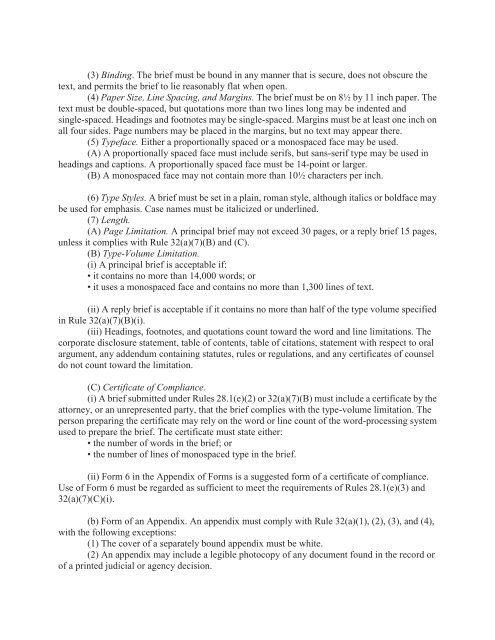Federal Rules of Appellate Procedure 2014-2015, 2014a
Federal Rules of Appellate Procedure 2014-2015, 2014a
Federal Rules of Appellate Procedure 2014-2015, 2014a
You also want an ePaper? Increase the reach of your titles
YUMPU automatically turns print PDFs into web optimized ePapers that Google loves.
(3) Binding. The brief must be bound in any manner that is secure, does not obscure the<br />
text, and permits the brief to lie reasonably flat when open.<br />
(4) Paper Size, Line Spacing, and Margins. The brief must be on 8½ by 11 inch paper. The<br />
text must be double-spaced, but quotations more than two lines long may be indented and<br />
single-spaced. Headings and footnotes may be single-spaced. Margins must be at least one inch on<br />
all four sides. Page numbers may be placed in the margins, but no text may appear there.<br />
(5) Typeface. Either a proportionally spaced or a monospaced face may be used.<br />
(A) A proportionally spaced face must include serifs, but sans-serif type may be used in<br />
headings and captions. A proportionally spaced face must be 14-point or larger.<br />
(B) A monospaced face may not contain more than 10½ characters per inch.<br />
(6) Type Styles. A brief must be set in a plain, roman style, although italics or boldface may<br />
be used for emphasis. Case names must be italicized or underlined.<br />
(7) Length.<br />
(A) Page Limitation. A principal brief may not exceed 30 pages, or a reply brief 15 pages,<br />
unless it complies with Rule 32(a)(7)(B) and (C).<br />
(B) Type-Volume Limitation.<br />
(i) A principal brief is acceptable if:<br />
• it contains no more than 14,000 words; or<br />
• it uses a monospaced face and contains no more than 1,300 lines <strong>of</strong> text.<br />
(ii) A reply brief is acceptable if it contains no more than half <strong>of</strong> the type volume specified<br />
in Rule 32(a)(7)(B)(i).<br />
(iii) Headings, footnotes, and quotations count toward the word and line limitations. The<br />
corporate disclosure statement, table <strong>of</strong> contents, table <strong>of</strong> citations, statement with respect to oral<br />
argument, any addendum containing statutes, rules or regulations, and any certificates <strong>of</strong> counsel<br />
do not count toward the limitation.<br />
(C) Certificate <strong>of</strong> Compliance.<br />
(i) A brief submitted under <strong>Rules</strong> 28.1(e)(2) or 32(a)(7)(B) must include a certificate by the<br />
attorney, or an unrepresented party, that the brief complies with the type-volume limitation. The<br />
person preparing the certificate may rely on the word or line count <strong>of</strong> the word-processing system<br />
used to prepare the brief. The certificate must state either:<br />
• the number <strong>of</strong> words in the brief; or<br />
• the number <strong>of</strong> lines <strong>of</strong> monospaced type in the brief.<br />
(ii) Form 6 in the Appendix <strong>of</strong> Forms is a suggested form <strong>of</strong> a certificate <strong>of</strong> compliance.<br />
Use <strong>of</strong> Form 6 must be regarded as sufficient to meet the requirements <strong>of</strong> <strong>Rules</strong> 28.1(e)(3) and<br />
32(a)(7)(C)(i).<br />
(b) Form <strong>of</strong> an Appendix. An appendix must comply with Rule 32(a)(1), (2), (3), and (4),<br />
with the following exceptions:<br />
(1) The cover <strong>of</strong> a separately bound appendix must be white.<br />
(2) An appendix may include a legible photocopy <strong>of</strong> any document found in the record or<br />
<strong>of</strong> a printed judicial or agency decision.


















